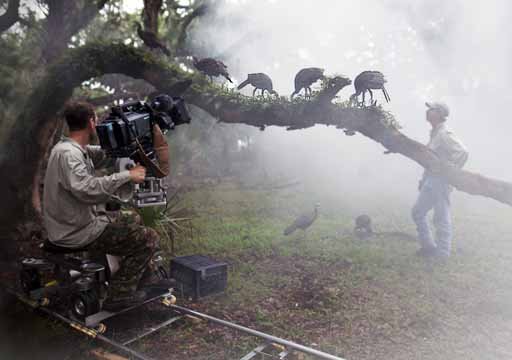Bonding with wild turkeys
This post contributed by Nadine Lymn, ESA Director of Public Affairs
Just in time for Thanksgiving, comes the true-life tale of a man who raised a rafter of sixteen wild turkeys, gaining a newfound understanding and deep appreciation for them in the process. My Life as a Turkey aired on PBS last week and shows how naturalist and wildlife artist Joe Hutto immersed himself in the lives of his young charges, becoming part of a strange “tribe” for 18 months.
Hutto has a strong interest in imprinting—most obvious in birds such as geese and turkeys, that imprint on their mother and follow them everywhere. Although farmers and others had taken advantage of this phenomenon for years, Austrian scientist Konrad Lorenz was the first to document the imprinting process.
The PBS film is a reenactment of the book Joe Hutto wrote about his experience, Illumination in the Flatwoods. In it, he incubates the eggs which a farmer has left at his house in the Florida Everglades and then raises the hatchlings to adulthood. The story chronicles Hutto’s gradual understanding of turkey communication, behavior, as well as the threats facing “his” young brood.
After a rat snake manages to squeeze into the pen where Hutto houses the young turkeys, or poults, and kills one, Hutto realizes he must not only reinforce the structure, but also spend every waking minute with the poults, from dawn to dusk. Indeed, his entire life revolves around the young turkeys. He bonds with them to such a degree that when they reach the stage of their life where they launch into flight and settle into a tree to roost, he feels left out and clamors up the tree to join them.
With their comically gangly necks coupled with surprisingly graceful bodies, the young wild turkeys follow Hutto through the Florida Everglades. They recoil yet are fascinated when they encounter their first dead animal and seemingly are also bothered by a tree stump, which they inspect for a long while and about which they make many turkey “comments.”
One of the most beautifully filmed and entertaining scenes shows Hutto strolling alongside the turkeys as they go on a “grasshopper hunt.” With barely a pause in their stride, the turkeys expertly snatch the grasshoppers from their grassy perches, as seen in the clip below.
http://youtu.be/dmYRi-3m6oA
Imprinting on ones’ parent early in life is a survival strategy. But when young animals imprint on humans, the result is often that when the animal reaches adulthood, it is unprepared to live on its own or it interacts inappropriately with its own species or with humans, often resulting in the animal’s death. To avoid this outcome, handlers involved in captive breeding programs to restore birds such as the endangered Whooping Crane or California Condor are costumed or use hand puppets to mimic an adult bird.
In the case of Hutto’s experience with the wild turkeys, this did not seem to be a problem; they left when they reached maturity, with the exception of one of the males, dubbed “Turkey Boy” by Hutto. He stayed with Hutto longer than all the other turkeys but one day suddenly attacked the naturalist, drawing blood. Hutto drives him off and after that Turkey Boy does not return.
I found myself drawn into this story, in large part because of the clear bond that develops between the man and the turkeys. A quick scan through the many comments on the online PBS site reveals that I’m not alone: nearly everyone who saw the piece seemed captivated by the story as seen from the sampling below:
“Watching now, utterly fascinating. Hutto is an affable, intelligent and engaged scientist and relator of these events….Beautiful! The most compelling thing I’ve seen on TV in years!….I was totally captivated by it all. Thanks to Joe for his dedication to these magnificent birds – and providing me a glimpse into their world…..What an awe inspiring story. Thanks Mr. Hutto for the moments you took me away from this crazy world ….into nature.”
As highlighted by the blog Learning from Dogs, Sam Wollaston’s article in The Guardian newspaper about the film, captures what sets it apart from other nature shows and why it so clearly resonates with viewers:
“My Life as a Turkey isn’t simply a wildlife film though. It’s not just about wild animals, it’s about one man’s relationship with wild animals, and that’s what makes it so fabulous. Serious animal behaviourists may not agree, but if you throw a human being in there, it all suddenly becomes a lot more interesting. I’m thinking Ring of Bright Water, Gorillas in the Mist, I’m definitely thinking Werner Herzog’s brilliant Grizzly Man about a man named Tim whose friendship with bears went wrong and he ended up inside one. My Life as a Turkey has something of Grizzly Man about it – a man obsessed, alone in a beautiful place, living with wild animals. But, although Joe was attacked, he didn’t end up inside one of his turkeys thankfully. There would have been a certain irony to that, especially if it had happened at Thanksgiving.”
Photo credit: BBC Joe Hutto film
